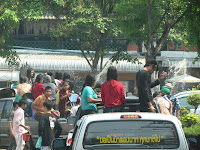The Buddhist temples in Thailand are everywhere and really are quite magnificent with their golden Buddha’s and intricate architecture
The night market in Chiang Mai
is like so many markets except with perhaps a different flavor. Would you care
for some fried short tailed cricket, fried silk worm, fried bamboo worm, giant
water bug, grass hopper or just plain cricket?!
I
guess this chicken can see what’s coming!
Another magnificent load!
Every household, shop, office
or factory has a small temple. One doesn’t have to go far to find a place to
buy where an impressive array of styles are on display
Northern Thailand seems to have
a liking for the rooster as a guardian against evil. This one like many others
stands guard outside this residence
A typical mountainous area in
the north of Thailand where forests are continuing to be destroyed by ‘slash
and burn’ agriculture. In 1960, 60% of Thailand was covered in forest; in 2000
only 30% is covered.
Mae Salong at 1,400 metres in
the very north is an interesting location. Tea, coffee and vegetables are grown
and it holds an intriguing local history; ……...
….Originally the area was
settled by the remnants of Chiang Kai Shek’s army who refused to surrender when
beaten by Mao’s communists in 1949. They settled on the Doi Mae Salong Mountain
and became the intermediaries between the opium growers and the Chinese. They
also maintained an army which was funded during the Korean War by the CIA and
fought 7 campaigns against China during 1950-52. They were later contracted by
the Thai Government through until 1982 to fight communist insurg+ents; many
were then repatriated to Taiwan or rewarded with Thai citizenship; interesting
history. This was a museum and memorial to those who died
At this tea house we met the
owner, a young lady whose grandfather was a member of the KMT Army. The Chinese
influence in the area has had a very positive effect on development as it has
in other localities where they have settled, even if it did start with the
opium trade and mercenary armies
Competition is always tough in the selling game. These two young
ladies forcefully put forward their case as to who had the best to offer
The Singha is a Thai
mythological beast who protects the owner from all sorts of evil that might
approach. These two were definitely the biggest that we had seen and certainly
checked Roadee out as we entered a small park
The Akha are one of the many
tribal groups that live in the north. They constitute the main work force in
the area including hand picking of the tea crops. This charming young lady was
very pleased when I bought some souvenir from her. Of course we were then allowed
to take her photo. Her costume is
traditional and worn regularly by all the Akha and not for the tourists. I love
her betel nut smile.
The northern most entry point
into Thailand from Myanmar at Mae Sai……
The geographical point where
the borders of Laos, Myanmar and Thailand come together is known as the Golden
Triangle because of the money that was generated in the area by the opium trade.
Situated on the NE border of Thailand and separated by the Mekong and Ruak
Rivers, it now has a place in history and survives on tourism and… a much
reduced drug trade
…….I should have known
better…..
This Mekong trader was burning
more oil than diesel and struggling upstream against a strong current
Just south of Chiang Rai we
found this White Temple designed by a talented Thai who also had a great
display of paintings on show – all in all we were very impressed!
For a temple it had some weird
interpretations from the usual Wat (Temple) ….
….some of which took an effort to
understand….
We returned to Chiang Mai for
the Buddhist New Year which is celebrated by Songkran also known as the water
throwing festival. We hadn’t really appreciated the seriousness of the,
throwing part, until we hit town or should I say the water hit us.
Chiang Mai is apparently the epicenter
for this activity which after tending to the religious side of washing the
Buddhist statues things really deteriorate into full on water throwing which
lasts for three days. It’s one great, good fun party with thousands of people
and very little in the way of alcohol. The police including members of the SWAT
in full gear, supplemented with very large water guns and soaked to the skin
joined in or maybe.. they really didn’t have an option. Couldn’t take any photos
as one would have had to have an underwater camera!























